JTF (just the facts): Published in 2017 by Pau Wau Publications (no book link, publisher site here). Coverless, Japanese stab bound with red string, 40 pages, with 21 color photographs. The book is housed in a rumpled Tyvek envelope with the title and artist’s name printed on the outside. The pages come French folded/perforated with images on both the inside and outside. There are no texts or essays. In an edition of 50 copies. (Cover and spread shots below.)
Comments/Context: In the fall of 2014, Chinese government officials proposed a series of changes to the Hong Kong electoral system, announcing reforms that screened candidates for elective office, effectively controlling which candidates could run for the most powerful posts in the city. Hong Kong people are broadly committed to the rule of law and effective participatory democracy, and since the 1997 handover that returned the territory back to China, Hong Kong political leaders have had to manage the complex challenges of running a separate democracy within the realm of the immensely larger Communist Party-controlled state of China.
When these restrictions were announced, protesters saw them for what they were and took to the streets, using the power of civil disobedience to communicate their rejection of the new approach. Strikes took place around the city, blocking key roadways and occupying portions of Central, Admiralty, Mong Kok, Causeway Bay and other neighborhoods, in some cases for several months. When the police used tear gas and water cannons to try to disperse the crowds, the protesters defended themselves with umbrellas, giving name to the Umbrella Movement.
In the simplest sense, Lele Saveri’s photobook Barricades documents the piles of available stuff used by protesters to clog up the streets. Metal crowd control fences seem to have been the most popular and effective tools repurposed for blocking highways, but industrious creativity was clearly applied to the problem. Bamboo construction scaffolding, municipal garbage cans, and wooden packing pallets (all plentiful and handy items in downtown Hong Kong) were also found to successfully add to the clutter, with huge rocks, plastic tarps, thick metal chains, and even long rolls of plastic wrap used to tie things together in impossibly dense knots.
Rather than seeing these fortifications as random conglomerations of available junk, Saveri’s eye captures the unexpected intention found in these roadblocks, his photographs turning them into the equivalent of art installations or additive sculpture. While one famous array of umbrellas was indeed a deliberate installation, for the most part, Saveri’s subjects seem entirely improvised, with layers of impediments metastasizing all over the city, the chaotic tangles of the barricades echoing the crowds on the sidewalks and the bustle of neon signage and architecture overhead.
Several of the images step back several paces or look down on the barricades from above, highlighting their function as separators. From these perspectives, we can see the entirety of structure blocking a multi-lane roadway, where crowd control gates form the backbone of larger building projects, the tops often decorated with a single umbrella. In one image, a hopelessly dense jumble of silver fences leaves a suited man dumbfounded as he ponders how to get to the other side. In another, a small opening in the barricade has allowed a flow of pedestrians to pass through, transforming a main thoroughfare into a walking park.
The best of Saveri’s images get in close, cropping the barricades down to busy linear abstractions. Plastic zip ties and clear packing tape seem to have been the fasteners of choice, tying clusters of bamboo poles into starbursts and thickets. The metal fences also provide plenty of geometric interest, their vertical slats creating striped rhythms and their repeated ladder forms flattened by the camera into interlocking nests and patterns.
Beyond the photographs themselves, the design and construction decisions that animate this photobook are extremely thoughtful. The photobook is housed in a crumpled envelope, not unlike those used for overnight mail, the bold lettering of the title echoing the repetitions of the barricades found inside. The envelope is sealed, so we have to open it to get to the book, that action providing the first barricade we have to cross. Once in hand, the pages of the photobook are French folded, with images printed on both the outside and inside of the folds. Usually, this construction method forces us to peek inside the folds to see the hidden imagery; here the folds have been perforated, so we are tacitly encouraged to break the folds to see the pictures. It’s hard to explain, but the process of tearing the pages apart is rather traumatic – the performations help, but the ripping process is noisy and seemingly fraught with danger. So again, we have to break barriers to get to the photographs, the barricade motif coming through in the way the pages have been bound. Even the string used to tie the binding connects back to the construction theme. All of these small design details increased my engagement with the book, the physicality of the effort required mimicking the protest activity in the images.
As an integrated whole, Barricades is a simple but elegant artistic statement. One part protest book, another part found geometries, the photobook successfully oscillates back and forth between intimate history and arm’s length abstraction. Honestly, I’m still a little unsettled by tearing the pages, but that risk-taking feeling is perhaps a fittingly energetic match for the popular revolt Saveri has so intelligently documented.
Collector’s POV: Lele Saveri does not appear to have consistent gallery representation at this time. As a result collectors interested in following up should likely connect directly with the artist via his website (linked in the sidebar).

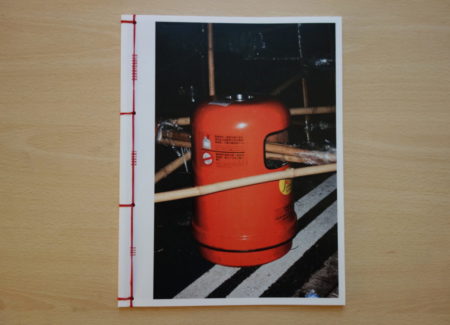
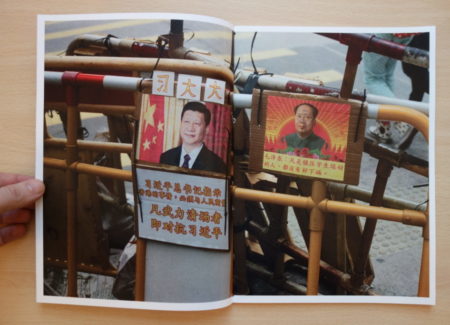




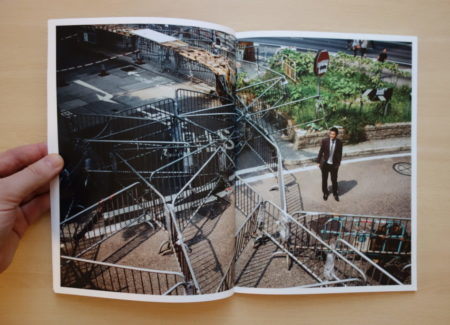




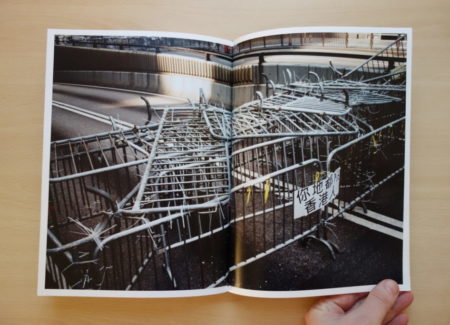

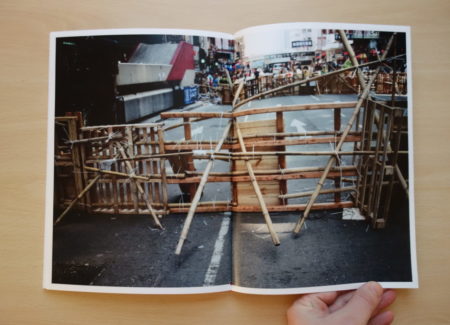

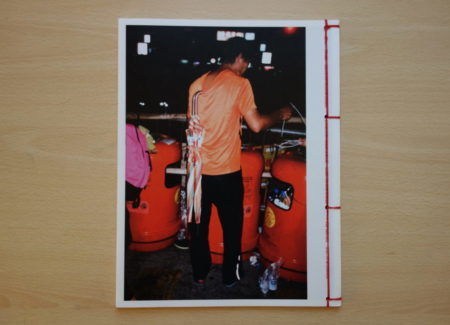





What’s routinely overlooked, particularly here in Britain, was that under our rule the former colony was only ever permitted a very minimal level of democracy which was introduced only very shortly before the handover. With breathtaking cynicism China was presented with a poisoned chalice while Chris Patton (the 28th and last Governor) literally sailed off into the sunset appearing as an exemplar of munificence.